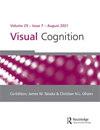信息太多 … 靶标选择难度对结合过程的影响
IF 1.7
4区 心理学
Q3 PSYCHOLOGY, EXPERIMENTAL
引用次数: 0
摘要
刺激和反应的结合是动作控制中的一个重要机制。刺激和反应的特征被集成到事件文件中。与存储的特征中的一个或多个的再次相遇导致包括先前集成的响应的先前事件文件的自动检索。干扰物-反应结合效应证明,即使是不相关的刺激也可以与反应结合,随后触发检索,从而对行为产生影响。然而,在先前的研究中,干扰物刺激的类型、干扰物呈现的方法和显示配置在目标选择难度方面存在很大差异。因此,在本研究中,我们改变了目标选择难度的程度,以研究其在干扰物-反应结合效应中的作用。结果表明,干扰物-反应结合和干扰物反应检索两个过程都与目标选择难度有关。这些结果与BRAC框架中最近的理论进行了讨论(Frings,C.、Hommel,B.、Koch,I.、Rothermund,K.、Dignath,D.、Giesen,C.、Kiesel,A.、Kunde,W.、Mayr,S.、Moeller,B.、Möller,M.、Pfister,R.和Philipp,A.(2020)。动作控制中的绑定和检索(BRAC)。认知科学趋势,24(5),375-387。https://doi.org/10.1016/j.tics.2020.02.004)。本文章由计算机程序翻译,如有差异,请以英文原文为准。
Too much information … The influence of target selection difficulty on binding processes
ABSTRACT The binding of stimuli and responses is an important mechanism in action control. Features of stimuli and responses are integrated into event files. A re-encounter with one or more of the stored features leads to automatic retrieval of the previous event file including the previously integrated response. The distractor-response binding effect evidenced that even irrelevant stimuli can be integrated with a response, subsequently trigger retrieval and thereby have an impact on behaviour. However, the type of distractor stimuli, the method of distractor presentation, and the display configuration largely differed in previous studies with regard to the target selection difficulty. In the present study, we thus varied the extent of target selection difficulty to investigate its role on the distractor-response binding effect. The results indicated that both processes, distractor-response binding and distractor-response retrieval are dependent on target selection difficulty. These results are discussed against recent theorizing in the BRAC framework (Frings, C., Hommel, B., Koch, I., Rothermund, K., Dignath, D., Giesen, C., Kiesel, A., Kunde, W., Mayr, S., Moeller, B., Möller, M., Pfister, R., & Philipp, A. (2020). Binding and Retrieval in Action Control (BRAC). Trends in Cognitive Sciences, 24(5), 375–387. https://doi.org/10.1016/j.tics.2020.02.004).
求助全文
通过发布文献求助,成功后即可免费获取论文全文。
去求助
来源期刊

VISUAL COGNITION
PSYCHOLOGY, EXPERIMENTAL-
CiteScore
4.20
自引率
10.00%
发文量
29
期刊介绍:
Visual Cognition publishes new empirical research that increases theoretical understanding of human visual cognition. Studies may be concerned with any aspect of visual cognition such as object, face, and scene recognition; visual attention and search; short-term and long-term visual memory; visual word recognition and reading; eye movement control and active vision; and visual imagery. The journal is devoted to research at the interface of visual perception and cognition and does not typically publish papers in areas of perception or psychophysics that are covered by the many publication outlets for those topics.
 求助内容:
求助内容: 应助结果提醒方式:
应助结果提醒方式:


